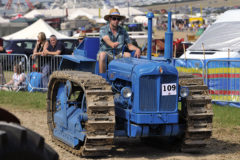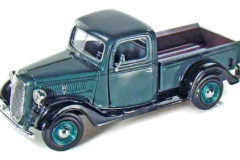Dennis lorries and fire engines
Posted by Chris Graham on 11th May 2022
Tim Gosling explains the story and how Dennis lorries and fire engines from Guildford ended up serving with the US Army during World War One.
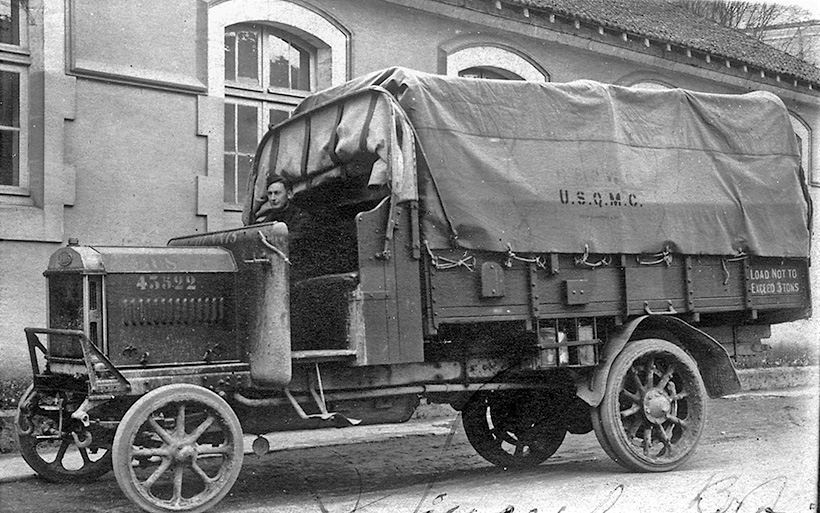
A Dennis clearly marked ‘US’ on the bonnet and ‘USQMC’ on the canvas.
In 2000 my brother Steve and I purchased the remains of five Great War Dennis subsidy lorries from Mick Giles in Bedfordshire. These lorries had been built to a government-approved design and purchasers would have received a cash subsidy for buying and maintaining the lorry on the understanding that in time of national emergency they could be taken into military service. Dennis lorry enthusiast Mick had been collecting Dennis subsidy lorry parts for some years with the intention of restoring one, but with other projects on the go he reluctantly agreed to part with them. My brother Steve, father Tony and I had recently completed the restoration of an ex-US Army FWD Model B truck from 1918 and were looking for a new restoration project. What we purchased from Mick comprised two very good chassis which had been stored under cover in a garage where they had been used to support a mezzanine floor, three further chassis which were generally beyond salvation but which still had a great deal of useful parts attached to them and a pile of axles and wheels which Mick had also collected over the years. The aim was to select the best parts that we had to restore just the one Dennis and see what we had left over at the end.
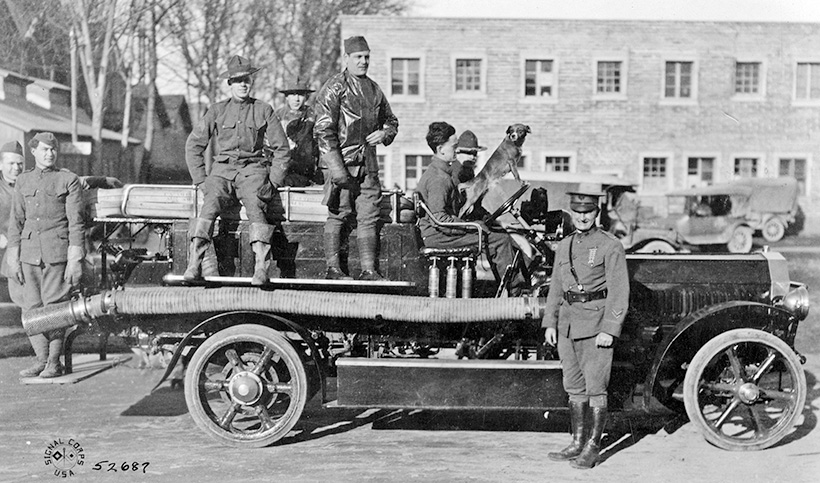
Fire stations in the United States often kept a dog as a mascot, something which has been replicated with this Dennis at St Nazaire docks.
One of the spare ‘donor’ chassis had come from the top of a hill near Wellington in Somerset. The chassis was in very poor condition, but although the front axle had completely rusted through this lorry did provide us with pedals, steering box, throttle linkage and the engine sub frame. As the chassis was dismantled to remove these useful parts something caught our eye. Forcibly jammed into the subframe and beneath a riveted plate was a button. A close examination of this revealed it to be a US Army tunic button from the Great War. It could not have fallen between these two plates unaided so it must have been forced into position. Our understanding was that Dennis lorries had only been used by the British Commonwealth forces so the presence of an American button was a real surprise. However, this did not impact upon our planned restoration so we took photographs of the button and left it as a question that we would never be able to solve.
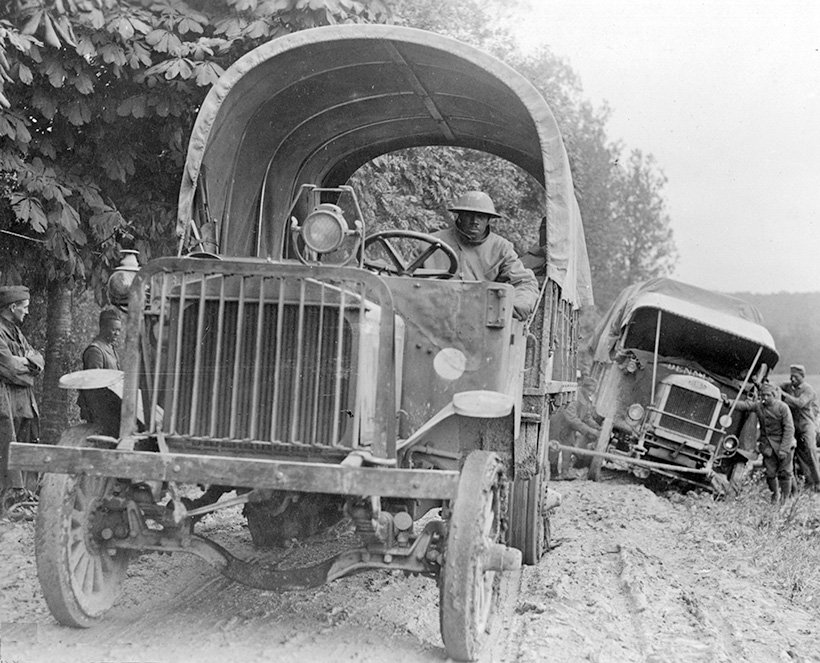
Photographed in September 1918 can be seen a US-built Heavy Aviation truck towing a Dennis back on to the road.
When undertaking any restoration the benefit of having original documents such as a manual and drawings cannot be overstated and luckily we obtained these. To compliment them I have always sought original postcards or photographs of early military vehicles which can occasionally provide useful details not always visible in the manuals. One of the first postcards that I found of a Dennis rather strangely had the letters USQMC (United States Quarter Master Corps) painted on the canvas and the letters US painted on the bonnet. The Dennis was otherwise the same as any other British one with the standard general service-type body and the traditional two-gallon petrol tins carried in a rack beneath it.
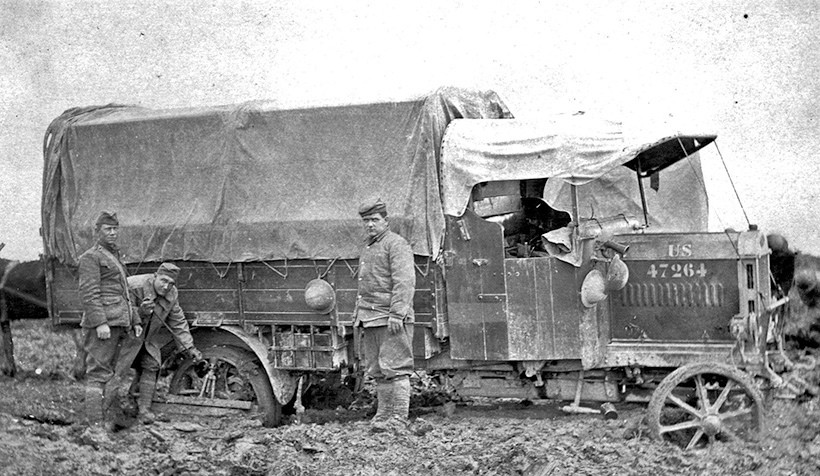
The driver has placed a jack on blocks of wood under the rear wheel as he attempts to free this heavily-mired Dennis from the mud.
Well, we now had proof of at least one Dennis having served within the US Army, but more was to follow. A stop over in Washington DC allowed me some time to visit the US National Archives and search through some of the many thousands of photographs held there. Another photograph of a US Army Dennis turned up. This time, the British ‘WD’ (War Department) markings had been painted through and a marking of what appeared to be a rattlesnake was visible on the side as well as the US marking on the bonnet. Sadly, time was not on my side and that was the only US Army Dennis photograph that I came away with. On returning to the UK I subsequently examined an index of the photographs held at the National Archives and ordered copies of any that I thought might be of interest. I now hit the jackpot and came away with many photographs, not only of the Dennis subsidy lorry but also rather surprisingly numerous ones of the Dennis N Type fire engines some of which were clearly marked ‘US’ on the bonnet. Now the question was, how did all these Dennis vehicles end up with the US Army and what happened to them all?
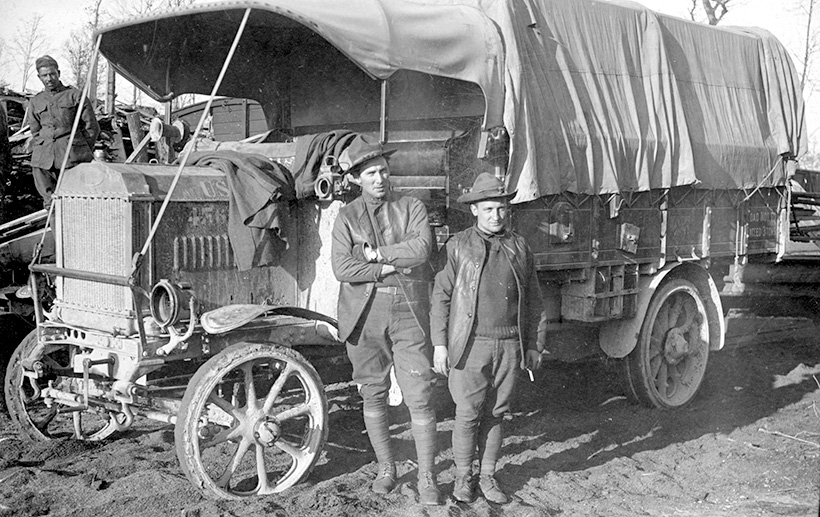
Transporting cut timber for the US Army Engineers, this Dennis, apart from having broken lamp glass, seems to be in a very tidy condition.
The United States declared war on Germany on April 2, 1917, with the first American troops landing in France two months later. Initially American troops were arriving in France at about 10,000 a month but this rapidly accelerated so that by the end of the war nearly two million American troops had arrived in Europe. With the limited amount of shipping available the transportation of the men was considered the priority and as a result the American Expeditionary Force (AEF) were short of equipment, especially motor vehicles. To make up this shortfall the Americans appealed to their allies for help.
Although the British War Department had been desperately short of motor transport at the start of the war, by the end of 1917 and into 1918 supplies had caught up with demand. The British sold to the Americans lorries which had been built by Dennis, AEC and Karrier as well as trucks which had previously been purchased from the American manufacturers of Pierce Arrow, Peerless and FWD. These American-made trucks were shipped to Great Britain as rolling chassis where they were fitted with a locally-built body, a style quite different from those manufactured in the USA. The History of the Ministry of Munitions recorded that by the end of the war the British had sold to the AEF a total of 4,306 lorries, 483 vans, 68 ambulances, 564 motorcycles and 550 motor cars. Unfortunately, a breakdown of these figures by manufacturer has not been kept but it seems likely that the number of Dennis lorries supplied were in the hundreds.
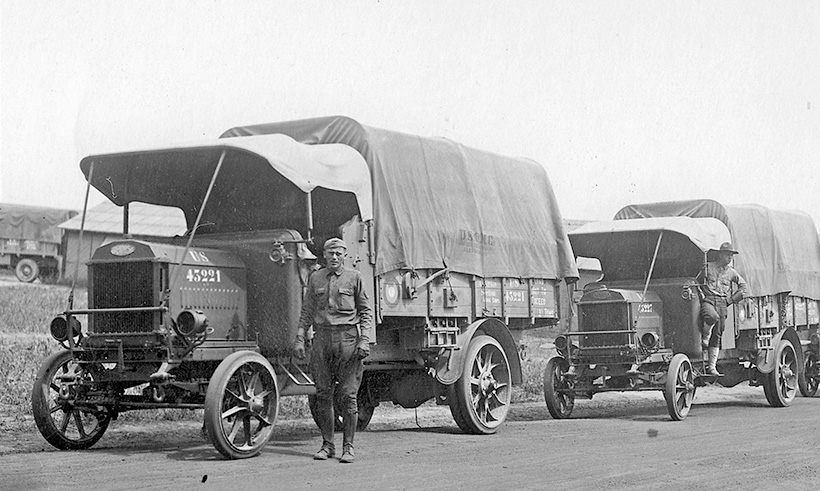
Only barely visible, this convoy of Dennis lorries carry US aircraft roundels, and the marking ‘Aviation Section Signal Corps’ (the precursor to the United States Air Force).
The Dennis lorries served with the AEF through France and even into Germany as part of the Army of Occupation. As the AEF began to withdraw from Europe their vehicles would not be returned to the USA and were gathered together in large yards for disposal. One American engineering unit which were using some Dennis lorries were directed to take all of their vehicles to such a yard. All of the trucks of American manufacture were neatly lined up while the drivers of the Dennis lorries were directed to take them to an area for scrapping. The drivers were mystified by this and recorded that they thought that this was ridiculous, as the Dennis had been by far the most reliable of any of the vehicles which they had operated. There was a reason for this draconian order. The US truck manufacturers had appealed to the Government that any surplus trucks in Europe should not be returned to America for disposal as the fragile automotive industry would be impacted by many thousands of second-hand trucks coming onto the market. They would have to be sold in France. The British motor industry successfully lobbied the British Government to prevent the US Army selling their surplus trucks in Britain, although all of the vehicles which had served with the British Army could be returned for disposal. It would appear that all of the British-manufactured lorries in service with the US Army were destined to be scrapped.
This feature is from the latest issue of Old Glory magazine, and you can get a brilliant, money-saving subscription simply by clicking HERE



